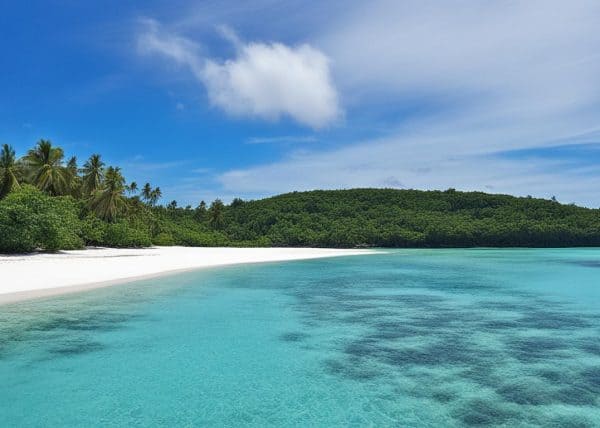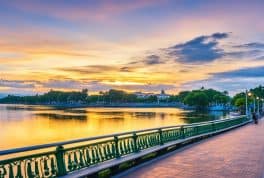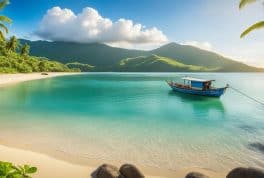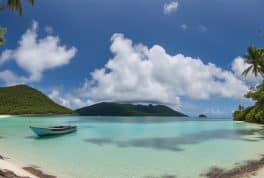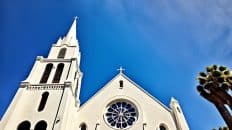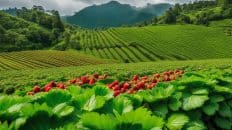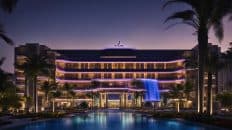Panay Island
Panay Island, in the Western Visayas of the Philippines, is a vibrant mix of stunning beaches, including Boracay, rich cultural festivals like Ati-Atihan, and diverse landscapes. Known as the "Seafood Capital of the Philippines," it offers a unique blend of indigenous, Malay, and Spanish influences, making it an ideal destination for those seeking natural beauty and cultural richness.
Top 10 things to see in Panay
- Boracay Island (Aklan Province): Known for its powdery white sand beaches, crystal-clear waters, and vibrant nightlife, Boracay is a must-visit destination for beach lovers. It offers various water sports activities, stunning sunsets, and a lively atmosphere.
- Iloilo City: This city is a blend of history and modern culture, famous for its Spanish colonial churches, old houses, and the Iloilo River Esplanade. The city is also known for its vibrant Dinagyang Festival.
- Miag-ao Church (Iloilo Province): A UNESCO World Heritage Site, this stunning example of Baroque architecture is renowned for its intricate facade and historical significance.
- Roxas City (Capiz Province): Dubbed as the "Seafood Capital of the Philippines," Roxas City offers fresh and delicious seafood. It’s also home to Baybay Beach, a perfect spot for enjoying local cuisine and a beautiful sunset.
- The Ruins of Muscovado Sugar Mills in Antique: These historical ruins are a testament to the island’s rich history in sugar production during the colonial era.
- Gigantes Islands (Iloilo Province): This remote group of islands is famous for its pristine beaches, clear waters, and natural beauty, offering a more secluded and peaceful beach experience.
- Ati-Atihan Festival (Kalibo, Aklan): Witness one of the Philippines' most colorful and vibrant festivals, with street dancing, parades, and cultural performances celebrating the Ati tribe’s history.
- Northwest Panay Peninsula Natural Park: Ideal for nature lovers, this protected area offers lush forests, diverse wildlife, and unique ecological features, providing great opportunities for hiking and wildlife watching.
- Sicogon Island (Iloilo Province): A rising star in tourism, this island offers unspoiled natural beauty with its clear waters, sandy beaches, and a laid-back vibe, making it perfect for relaxation and escape from the crowds.
- The Heritage Sites of Iloilo: Explore the rich history of Iloilo by visiting its well-preserved heritage sites, including old mansions, churches, and historical buildings that showcase the architectural and cultural heritage of the region.
Guides and Tours
Cities on Panay
- Iloilo City
- Roxas City
- Passi City
- Kalibo
- San Jose de Buenavista
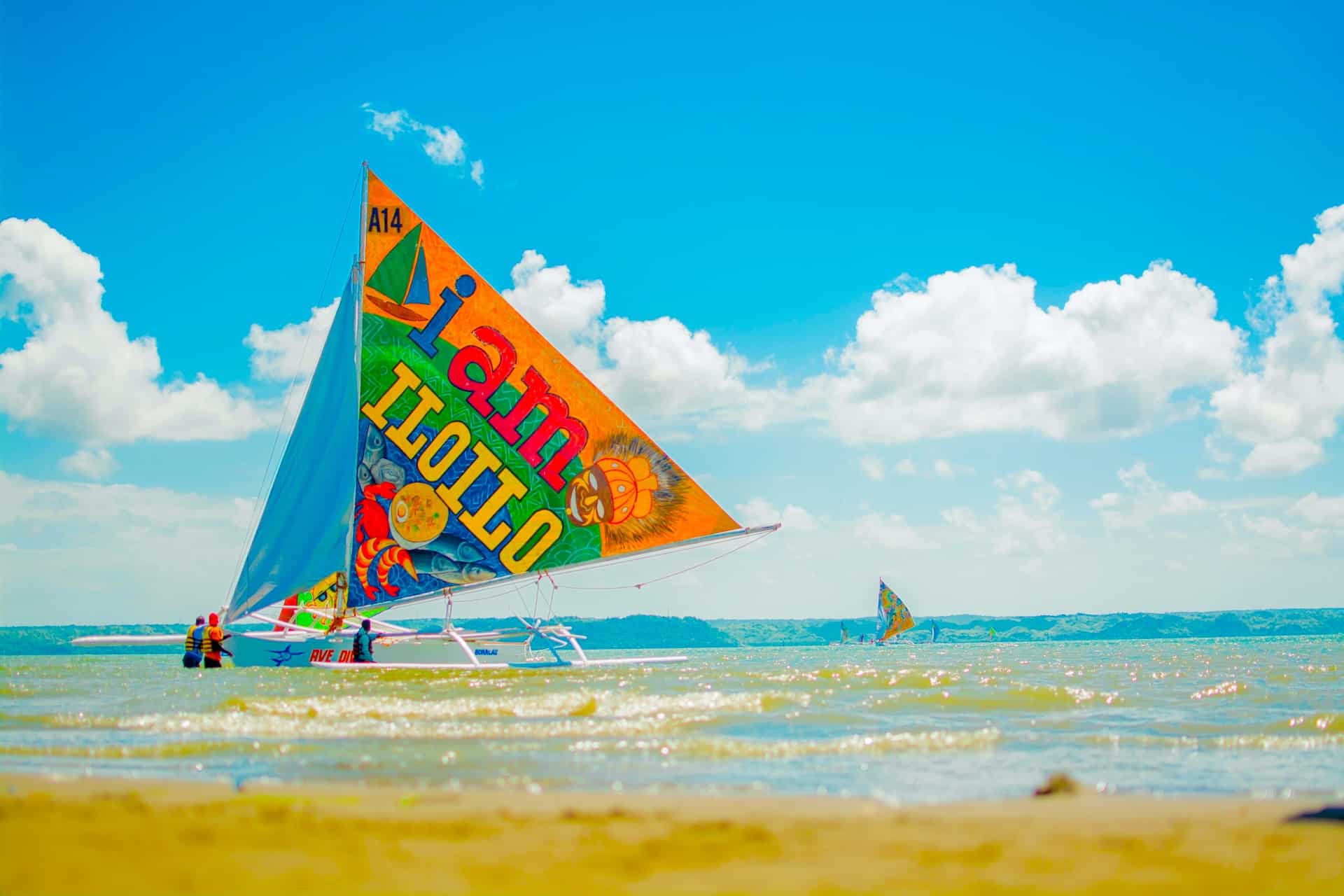
Top 10 Questions and Answers about Panay
1. What is Panay Island and where is it located?
Answer: Panay Island is one of the islands in the Visayas group in the central part of the Philippines. It is situated southeast of the larger island of Luzon and northwest of the smaller island of Negros.
2. What are the major cities and provinces on Panay Island?
Answer: Panay Island is divided into four provinces: Aklan, Antique, Capiz, and Iloilo. Major cities include Iloilo City, which is the largest city on the island, Roxas City in Capiz, and Kalibo in Aklan.
3. What is the significance of Panay in Philippine history?
Answer: Panay has a rich history, including being one of the earliest islands in the Philippines to have been colonized by the Spaniards. The island is also known for the historic event known as the barter of Panay, which is a legendary trade agreement between the indigenous Ati people and Malay settlers.
4. What are some popular tourist attractions in Panay?
Answer: Popular attractions include the white sandy beaches of Boracay in Aklan, the historic churches like Panay Church, the beautiful Iloilo River Esplanade in Iloilo City, and natural attractions such as the Northwest Panay Peninsula Natural Park.
5. What festivals are celebrated in Panay?
Answer: Panay is famous for its vibrant festivals, most notably the Ati-Atihan Festival in Aklan and the Dinagyang Festival in Iloilo. These festivals feature colorful parades, street dancing, and reflect the rich culture and history of the island.
6. What languages are spoken in Panay?
Answer: The primary languages spoken in Panay are Hiligaynon (Ilonggo) and Kinaray-a, with Filipino and English widely used as secondary languages.
7. What are the main industries in Panay?
Answer: The main industries in Panay include agriculture, fishing, and tourism. The island is also known for traditional crafts like the weaving of piña cloth.
8. What is the role of Panay in the Philippines’ economy?
Answer: Panay plays a significant role in the Philippines' economy, especially through its agricultural produce, fisheries, and as a growing tourism destination. Its development in sectors like technology and infrastructure also contributes to the national economy.
9. What is the transportation system like in Panay?
Answer: Panay has a well-developed transportation system, including roads, ports, and airports. The island is connected internally by buses, jeepneys, and tricycles, and externally by several ports and airports, including the Iloilo International Airport.
10. What environmental challenges does Panay face?
Answer: Panay faces several environmental challenges, such as deforestation, pollution, and the impacts of climate change. Conservation efforts are ongoing to protect its diverse ecosystems and to promote sustainable development practices.
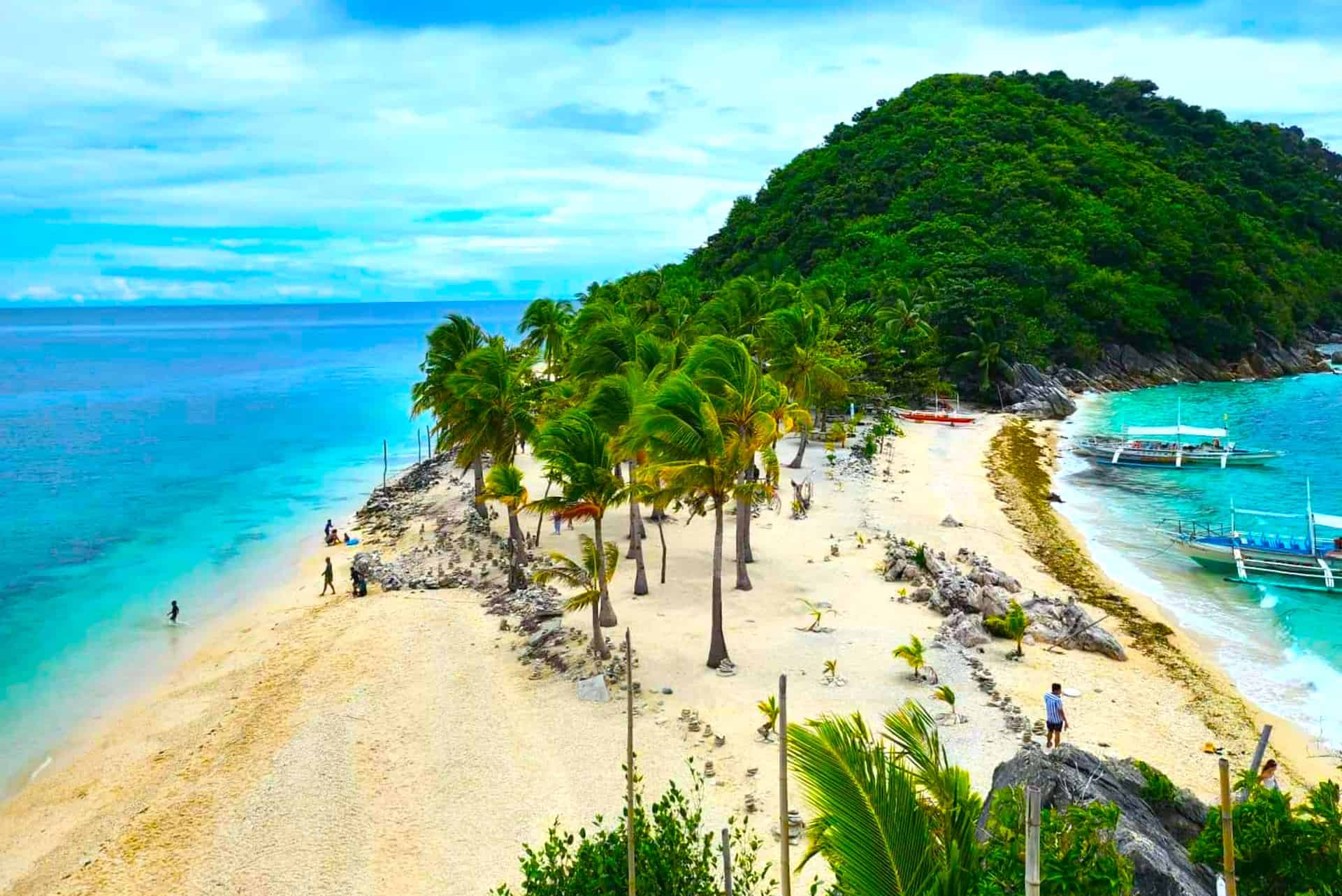
Why you should visit Panay
Panay Island: A Hidden Gem in the Heart of the Philippines
Introduction to Panay's Enchantment
Nestled in the central part of the Philippine archipelago, Panay Island emerges as a destination of unparalleled charm and diversity. This comprehensive review aims to illuminate why Panay should be a top choice for travelers seeking an immersive experience in culture, nature, and adventure.
Cultural Richness: A Journey Through Time
Panay Island is not just a place but a living museum of Philippine history and culture. The island's story is woven through centuries, beginning with the legendary barter of Panay, a foundational event that marks the exchange between the indigenous Ati people and the Malay settlers. This cultural tapestry is further adorned by the influences of Spanish colonialism, visible in the architecture of centuries-old churches and heritage sites.
One cannot talk about Panay without mentioning its vibrant festivals. The Ati-Atihan Festival in Kalibo and the Dinagyang Festival in Iloilo are spectacles of color, dance, and music, celebrating the island's rich history and diverse influences. These festivals are not just tourist attractions but a deep dive into the soul of Panay, offering a glimpse into the island's spirit and its people's resilience and joy.
The Natural Splendor of Panay
Panay is a paradise for nature lovers. The island is blessed with an array of natural landscapes, from the pristine white beaches of Boracay to the unspoiled mountains and forests of Antique. The Northwest Panay Peninsula Natural Park is a haven for biodiversity, home to rare species and lush vegetation. The park offers a serene escape from the bustle of urban life, with opportunities for trekking, bird watching, and connecting with nature.
The beaches of Panay, particularly Boracay, need no introduction. Known globally for their powdery white sands and crystal-clear waters, these beaches offer a slice of paradise on earth. Whether it’s the vibrant energy of Boracay or the tranquil shores of less-visited islands like Sicogon, Panay's beaches cater to all preferences.
The Gastronomic Delights of Panay
Panay's culinary landscape is as diverse as its culture. The island is a gastronomic haven, offering a blend of indigenous, Malay, Spanish, and Chinese influences. Seafood lovers will find themselves in heaven in Roxas City, the seafood capital of the Philippines, where fresh and sumptuous seafood is a daily indulgence. Iloilo City, with its famous La Paz Batchoy and Pancit Molo, offers a taste of local flavors that will delight any palate.
Moreover, the island's traditional markets and street food stalls provide an authentic culinary experience, allowing travelers to savor the local cuisine and connect with the community.
The People: Heart and Soul of Panay
The true essence of Panay lies in its people. Known for their warmth and hospitality, the locals of Panay make every visit memorable. Engaging with the community, whether through casual conversations at a local café or during the festive celebrations, visitors will feel a genuine sense of welcome and belonging.
The resilience and creativity of the people of Panay are remarkable. From artisans preserving traditional crafts like the weaving of piña cloth to the fishermen and farmers upholding their way of life, the locals are the heart and soul of the island, inviting visitors to share in their stories and traditions.
Adventure and Leisure: A Diverse Offering
Panay offers a range of activities for the adventurous soul. From island hopping and water sports in Boracay to hiking and exploring the less-trodden paths in the inland regions, there’s something for every type of adventurer. For those seeking relaxation, the island’s numerous spas, resorts, and tranquil beaches provide the perfect setting for unwinding and rejuvenation.
Cultural tours, heritage walks, and visits to historical landmarks like the Miag-ao Church offer a more laid-back but equally enriching experience for those interested in the cultural and historical aspects of the island.
Accessibility and Accommodation
Panay is easily accessible, with international and domestic flights to Iloilo and Kalibo, and well-connected road and ferry networks making travel within the island convenient. Accommodation options range from luxury resorts to budget-friendly homestays, catering to all preferences and budgets. The island’s infrastructure, while continually developing, provides a comfortable and safe experience for travelers.
Conclusion: Why Panay is a Must-Visit
In conclusion, Panay Island is a destination that offers a rich tapestry of experiences. It is a place where history, culture, nature, and modernity coalesce to create a travel experience that is both diverse and authentic. Whether it's the allure of its festivals, the tranquility of its natural landscapes, the warmth of its people, or the adventure and leisure activities, Panay promises something special for every visitor.
A trip to Panay is more than just a holiday; it is an opportunity to immerse oneself in a vibrant and enduring culture, to connect with nature, to savor delightful culinary experiences, and to create memories that last a lifetime. Panay is not just a destination; it is an experience, a journey into the heart of the Philippines.
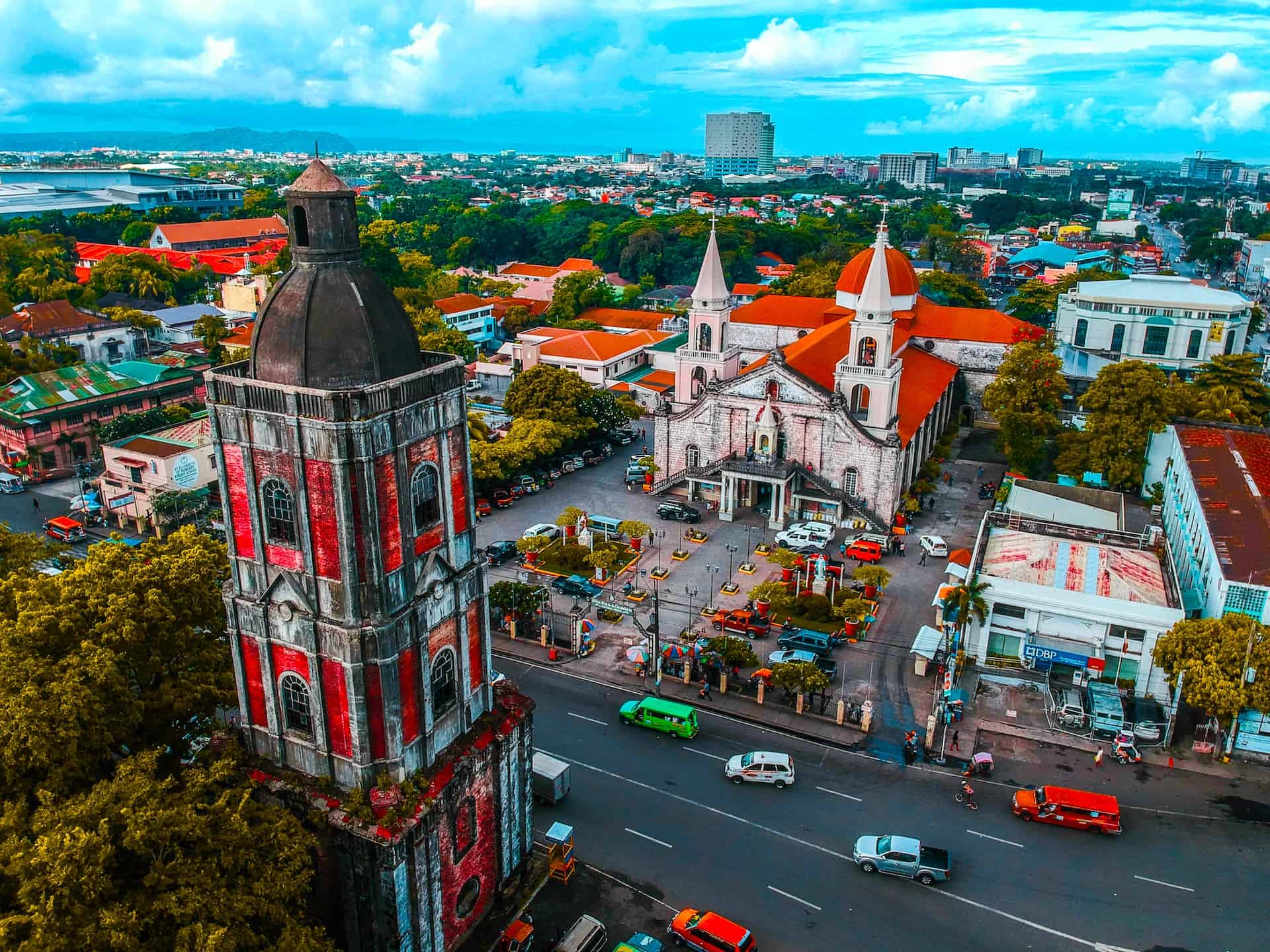
Panay Facts
1: Geography and Nature of Panay
Panay Island, nestled in the heart of the Philippine archipelago, is a geographical marvel that embodies the lush, vibrant essence of the Western Visayas region. As the sixth-largest island in the Philippines, Panay serves as a testament to the country’s diverse and rich natural heritage. This section delves into the intricate tapestry of landscapes, seas, and ecological wonders that make Panay a microcosm of the Philippines' natural beauty.
1.1 The Geographical Tapestry of Panay Island
Panay Island, located southeast of the main cluster of Philippine islands, is surrounded by the Sulu Sea to the southwest and west and the Sibuyan Sea to the northeast located southeast, marking it as a significant geographical entity. The island is divided into four provinces: Iloilo, Aklan, Capiz, and Antique, each contributing its unique character to the island's overall identity. The island’s landscape is a harmonious blend of rolling hills, verdant plains, and a network of rivers that enrich its fertile land.
The Guimaras Strait, lying between mainland Panay and the smaller island province of Guimaras, is not just a vital waterway but also a scenic marvel, offering breathtaking views of the sunset over the Panay Gulf. The strait has been a witness to the island’s vibrant history and is a crucial conduit for trade and travel within the region. To the southwest, north and the north, the smaller islands dotting the seascape add to the picturesque quality of Northern- uss Panay itself, serving as idyllic retreats and rich fishing grounds.
1.2 The Natural Splendor of Rivers and Seas
Panay’s natural beauty is further accentuated by its many rivers, which are not only vital sources of freshwater but also integral to the island’s ecosystem and local livelihoods. These rivers, meandering through the provinces, have been the lifelines for communities for centuries, supporting agriculture and fishing. The rivers of Panay, with their rich biodiversity, are a testament to the island's commitment to preserving its natural heritage.
The seas surrounding Panay Island, namely the Sulu and Sibuyan Seas, are as integral to its identity as its land. These seas are abundant with marine life, making them popular among local fishermen and international researchers alike. The waters are also vital routes for boats connecting Panay with other islands in the Visayas, such as Negros and Cebu, facilitating cultural and economic exchanges that have shaped the island's history.
1.3 Flora, Fauna, and Ecological Significance
Panay Island is not only a geographical wonder but also an ecological treasure trove. The island is home to a plethora of species, some endemic and others migratory, making it a biodiversity hotspot. One of the most notable species is the Panay monitor lizard, a symbol of the island’s unique wildlife. The lush forests and diverse habitats across the island provide sanctuary to a myriad of species, contributing to the Philippines' reputation as one of the world’s mega-diverse countries.
The Northwest Panay Peninsula Natural Park stands as a beacon of conservation efforts on the island. This park is a haven for wildlife and a crucial area for environmental research and education. The park's existence underscores Panay's commitment to balancing ecological preservation with human development, a challenge faced by many regions in the Philippines.
1.4 Rivers as the Lifeline of Panay
The rivers of Panay are more than just bodies of water; they are the arteries that sustain life across the island. From the provision of irrigation for agriculture to being sources of freshwater, these rivers play a critical role in the everyday life of Panay’s inhabitants. The rivers also hold cultural significance, having been the sites of ancient settlements and modern-day festivals.
1.5 Challenges and Conservation Efforts
Despite its natural beauty and ecological importance, Panay Island faces challenges common to many parts of the Philippines. Environmental concerns such as deforestation, pollution, and the impact of climate change pose significant threats to the island's ecosystems. The delicate balance between development and conservation is a constant endeavor for the local governments and communities.
Conservation efforts on Panay are a collaborative endeavor, involving local communities, government agencies, and international organizations. Initiatives to protect the island's natural habitats and species, such as the Panay monitor lizard, are ongoing. These efforts are not only vital for the island's ecological health but also for preserving the rich natural heritage for future generations.
1.6 Panay: A Microcosm of Philippine Geography
Panay Island, with its diverse landscapes, rich waters, and vibrant ecosystems, is a microcosm of the Philippine islands' geographical diversity. The island's unique blend of natural features – from the Guimaras Strait to its many rivers, from the rolling hills of its interiors to the rich seas that envelop it – showcases the myriad facets of nature in the Philippines. Panay is not just an island; it is a vivid representation of the Philippine archipelago’s natural splendor and ecological significance.
In conclusion, Panay Island stands as a testament to the Philippines' rich geographical and natural heritage. From its strategic location in the Western Visayas region to its diverse ecosystems, Panay encapsulates the beauty and complexity of nature in the Philippines. As we explore further into this enchanting island, the intricate connections between its geography, culture, and history become increasingly apparent, painting a picture of an island that is as multifaceted as it is integral to the narrative of the Philippine islands.
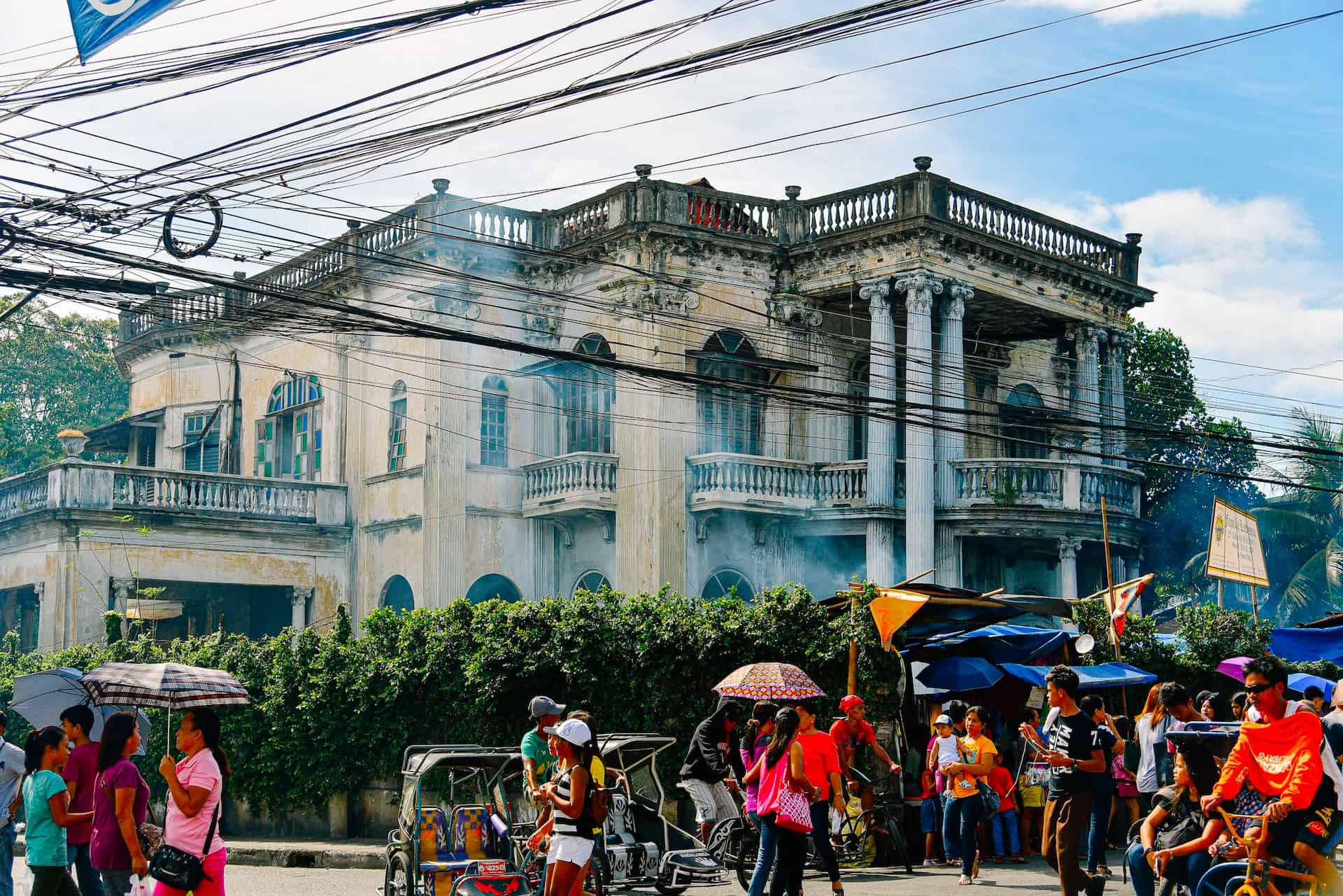
2: History and Culture of Panay
Panay Island, a significant part of the Philippine Islands, holds a history as diverse and intricate as its landscapes. The island's past, intertwined with the rich tapestry of Philippine history, tells a story of ancient settlements, colonial encounters, and enduring cultural traditions. This section explores the historical evolution of Panay, shedding light on the island's role in shaping the cultural and historical narrative of the Western Visayas region and the Philippines at large.
2.1 The Early Inhabitants and the Malay Legacy
The history of Panay is deeply rooted in the early Malay settlements. Legend speaks of the ten datus, leaders of Malay origin, who fled from the tyranny of Datu Makatunaw in Borneo and found refuge in the welcoming shores of Panay. This migration, a cornerstone of Panay's history, laid the foundations of the island's culture and society. The barter of Panay, a pivotal event where the ten datus had reportedly bought the island from the indigenous Ati people, is a story that has been passed down through generations, becoming an integral part of Panay's folklore.
The Malay influence profoundly shaped the cultural fabric of Panay, introducing aspects of their language, customs, and governance. This influence is still evident today, particularly in the traditions and practices of the Panay Bukidnon, an indigenous group known for their rich cultural heritage, including their intricate clothing and enduring customs.
2.2 The Spanish Era and the Birth of Panay's Colonial Legacy
The arrival of the Spaniards led by Miguel Lopez de Legazpi in the 16th century marked a new chapter in Panay's history. Panay became one of the first islands in the Philippines to experience Spanish colonization, with the establishment of the second Spanish settlement in the country. The Spaniards settled in various parts of the island, including what is now known as Iloilo City, transforming it into a key center for religion, culture, and education in the Visayas.
The Spanish influence on Panay is most famously epitomized in the grandeur of Panay Church, a historic church that stands as a testament to the island's colonial past. The church, with its majestic architecture and religious significance, has been a beacon of faith and resilience for the people of Panay for centuries.
2.3 The Resilience of Panay During World War II
The Panay incident during World War II is a significant event in the island's history. The bombing of the USS Panay by Japanese forces in 1937, while the gunboat was anchored in Chinese waters, escalated tensions leading up to the war. During the Japanese occupation of the Philippines, Panay became a focal point of resistance. The island's strategic location and the bravery of its inhabitants played a crucial role in the struggle for freedom and independence.
2.4 The Cultural Mosaic of Panay
Panay's history is not only a tale of conquests and conflicts but also a narrative of cultural integration and evolution. The island is a melting pot of indigenous traditions, Malay influences, Spanish colonial heritage, and modern Filipino culture. This cultural mosaic is evident in the island's festivals, cuisine, arts, and everyday life.
The festivals of Panay, such as the Ati-Atihan in Aklan and the Dinagyang in Iloilo, are vibrant celebrations that blend indigenous practices with religious motifs introduced during the Spanish era. These festivals, characterized by colorful costumes, rhythmic drumbeats, and lively street dancing, attract visitors from across the globe, showcasing the island's rich cultural heritage.
2.5 The Evolution of Panay's Urban Landscape
Over the centuries, Panay has evolved from a cluster of ancient settlements into a dynamic region with bustling cities and towns. Iloilo City, the largest city on the island, stands as a symbol of this transformation. Once a small fishing village, Iloilo City has grown into a major urban center in the Visayas, known for its historic buildings, vibrant economy, and rich cultural scene.
Other key cities on the island, and smaller islands such as Roxas City in Capiz and San Jose de Buenavista in Antique, have also played significant roles in Panay's development. These cities, each with their distinct character and history, contribute to the island's diversity and dynamism.
2.6 The Continuing Saga of Panay's History
The history of Panay is a saga that continues to unfold. The island has witnessed the ebb and flow of different cultures, the rise and fall of empires, and the relentless pursuit of its people for progress and identity. Today, Panay stands as a living museum of Philippine history, a place where the past and present converge to create a unique narrative.
As we delve deeper into the story of Panay, we uncover layers of history that reveal the resilience, adaptability, and richness of the island's culture. From ancient Malay settlers to Spanish colonizers, from wartime resilience to modern-day progress, Panay encapsulates the diverse and complex history of the Philippines. The island's story is not just a chapter in Philippine history; it is a testament to the enduring spirit of its people and their unyielding connection to their land and heritage.
In conclusion, the history and culture of Panay are as diverse and vibrant as the island itself. From its ancient Malay roots to its colonial past, from its wartime struggles to its cultural celebrations, Panay embodies the essence of Philippine history and culture. As we continue to explore the many facets of this remarkable island, we gain a deeper understanding of the forces that have shaped not only Panay but the entire Philippine archipelago. Panay is not just an island; it is a living narrative of history, resilience, and cultural richness.
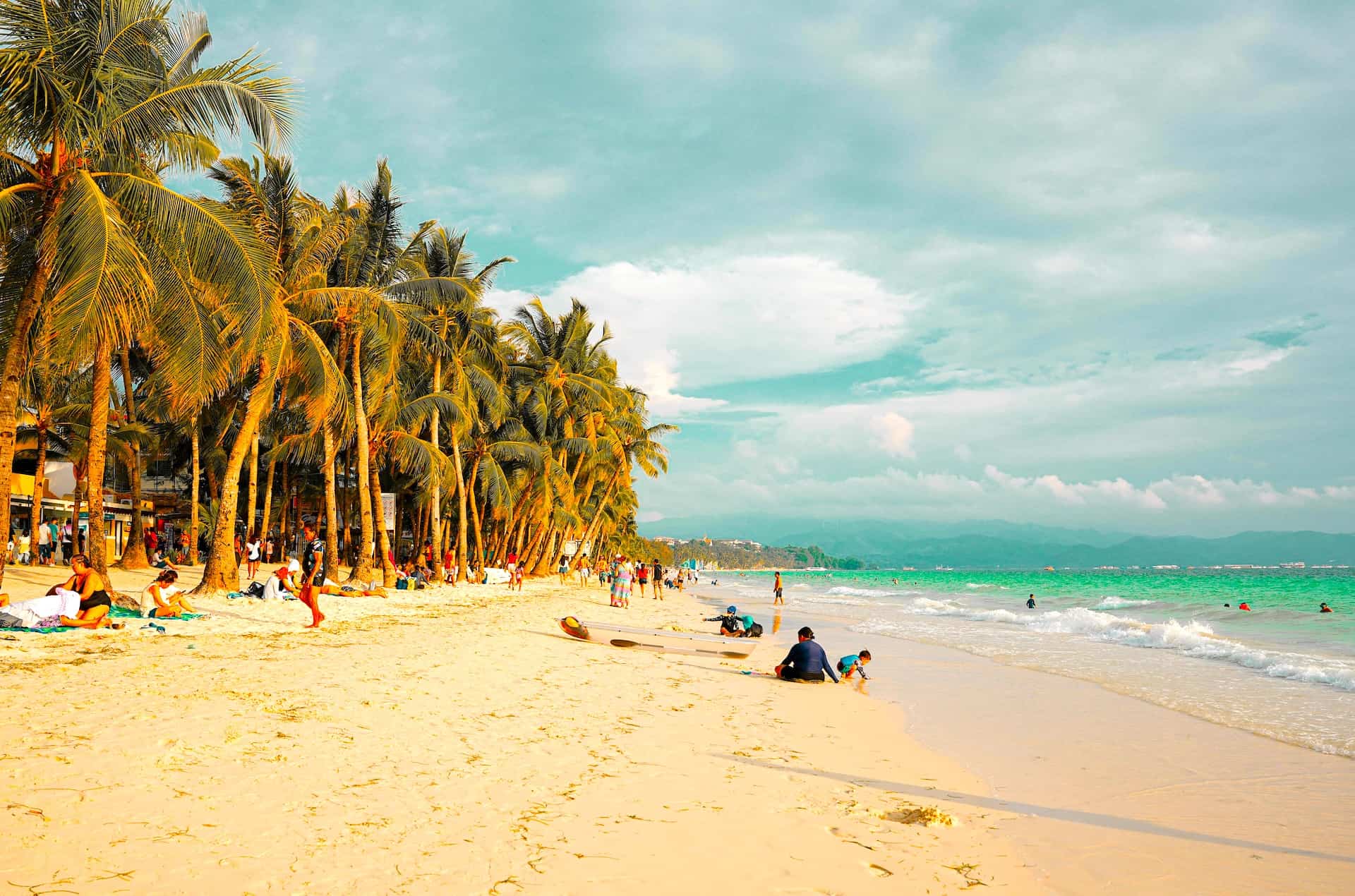
3: Cities and Provinces of Panay
Panay Island, a gem in the Philippine archipelago, is a land of contrasts and diversity. This section delves into the heart of Panay, exploring its cities and provinces, each with its unique character and contribution to the island's identity. From bustling urban centers to serene rural landscapes, Panay encapsulates the varied facets of life in the Western Visayas region.
3.1 Iloilo: The Cultural Heart of Panay
Iloilo Province, occupying the southeastern and western part of of Panay, is a tapestry of history, culture, and modernity. Iloilo City, the capital and largest city on Panay Island, is a hub of economic and cultural activity. Known as the "City of Love" in the Philippines, it is renowned for its heritage buildings, vibrant festivals, and exquisite cuisine. Iloilo City's rich history is reflected in its colonial-era churches, old houses, and the famous Iloilo River Esplanade, a testament to the city's blend of history and contemporary development.
Beyond the city, Iloilo Province is dotted with quaint towns and scenic countryside. The island province is a patchwork of rice fields, sugar plantations, and fishing villages, showcasing rural life in Panay. The town of San Joaquin, with its historic church and quiet beaches, exemplifies the island province's charm.
3.2 Aklan: The Gateway to Boracay
Northwest of Panay lies Aklan Province, known primarily as the gateway to the world-famous Boracay Island. Kalibo, the capital town of Aklan, is not just an entry point to Boracay but a destination in its own right. It is famous for the Ati-Atihan Festival, a vibrant celebration that attracts tourists from all over the country and the world. The festival, with its colorful parades and indigenous music, is a significant cultural event on Panay Island, showcasing the island's rich heritage.
Aklan is also home to other towns like Malay, which provides access to Boracay, and Altavas, known for its historic sites and serene landscapes. The province's craft industry, particularly famous legend its piña cloth weaving, is another highlight, adding to Panay's cultural tapestry.
3.3 Capiz: The Seafood Capital of the Philippines
To the north, south located southeast and northeast of Panay, Capiz Province is known as the "Seafood Capital of the Philippines." Roxas City, the provincial capital, sits by the Panay Gulf and is famous for its fresh seafood, particularly its delectable crabs and shellfish. Roxas City's Baybay Beach is a popular spot for both locals and tourists, offering a picturesque view of the sunset over the Sulu Sea.
Capiz is not just about seafood; it is rich in folklore and history. The island province is steeped in tales of aswangs (mythical creatures in Filipino folklore), adding a mystical dimension to its cultural landscape. The town of Pan-ay, another significant town in Capiz, is home to the largest Catholic bell in Asia, housed in the Santa Monica Church, a symbol of the province's deep-rooted Catholic faith.
3.4 Antique: The Rustic and Unspoiled Province
On the western side of Panay, bordering the Sulu Sea, lies Antique Province. Known for its rugged terrain and unspoiled beauty, Antique offers a different side of Panay's character. The province is a haven for eco-tourists, with attractions like the Malumpati Cold Spring and the raffling Nogas Island.
San Jose de Buenavista, the capital of Antique, serves as the province's commercial and political center. Despite its urbanization, San Jose retains a laid-back charm, with its quiet streets and friendly locals. The town of Culasi is another highlight of Antique, serving as the gateway to the majestic Mt. Madia-as, an essential site in Panay's folklore.
3.5 The Interplay of Urban and Rural in Panay's Provinces
The four provinces' of Panay, each with its unique identity, create a mosaic of urban and rural experiences. While Iloilo and Capiz boast bustling cities, Aklan and Antique offer more rustic and serene environments. This interplay between urban and rural is a defining characteristic of Panay Island, reflecting the diversity of experiences available to both residents and visitors.
3.6 The Economic and Social Fabric of Panay's Provinces
The economic landscape of Panay's provinces is as diverse as their geographical and cultural features. Agriculture plays a significant role, with rice, sugar, and seafood being the primary products. The tourism industry is another economic driver, especially in Aklan and Iloilo, buoyed by attractions like Boracay and the Dinagyang Festival.
Socially, the provinces of Panay are a blend of traditional Filipino values and modern influences. The strong sense of community and kinship ties is evident in the island's numerous festivals and celebrations. At the same time, the influence of global culture is visible in the urban areas, especially in education and lifestyle trends.
3.7 The Future Prospects of Panay's Provinces
As Panay continues to develop, its provinces face the challenge of balancing growth with sustainability. Efforts to preserve the island's natural beauty and cultural heritage are crucial in the face of rapid urbanization and environmental concerns. The provinces of Panay are at a crossroads, with the potential to forge a path of sustainable development that respects their rich history and unique identities.
In conclusion, the cities and provinces of Panay are integral to understanding the island's complex tapestry. From the bustling streets of Iloilo City to the serene shores of Antique, Panay offers a kaleidoscope of experiences. The provinces of Panay, with their distinct histories, cultures, and landscapes, contribute to the island's rich mosaic, making it not just a geographic entity but a vibrant, living community. As we delve deeper into the essence of Panay, we uncover the myriad stories and traditions that make this island a vital part of the Philippine archipelago.4: Contemporary Panay - A Modern Landscape
In the heart of the Philippines lies Panay Island, a beacon of progress amidst the Western Visayas region. This section delves into the contemporary landscape of Panay, exploring how this historic island harmonizes its rich past with the demands and opportunities of the modern era. From economic developments to technological advancements, Panay is an island not just steeped in history, but also striding confidently into the future.
4.1 The Economic Transformation of Panay
The economic landscape of Panay has undergone significant transformation in recent years. The island, once primarily known for its agricultural and fishing industries, is now a burgeoning hub for commerce and technology in the Philippines. Iloilo City, the largest city on the western part of Panay Island, stands at the forefront of this transformation. It has evolved from a historic city into a modern metropolis, attracting investment and fostering innovation.
The growth of technology, particularly the introduction of Panay Piso WiFi, has revolutionized access to information, data and connectivity across the island. This technological leap has not only enhanced communication but also data security and has also opened up new avenues of data, for education and business, significantly impacting the daily lives of Panay’s residents.
4.2 Healthcare and Social Services
In tandem with economic growth, Panay has made strides in improving healthcare and social services. The focus on Panay health care has led to the establishment of better-equipped hospitals and more accessible medical facilities, especially in urban centers like Iloilo City and Roxas City. These developments have greatly improved the quality of life for the island's inhabitants, providing them with essential health services closer to home.
Efforts have also been made to address social issues such as education and housing. Initiatives like affordable housing projects in areas such as Panay Avenue in Quezon City have been instrumental in providing decent living conditions for the less privileged. Educational reforms and investments have further contributed to the social upliftment of Panay’s communities.
4.3 Infrastructure and Connectivity
Infrastructure development has been a key driver of Panay’s modernization. The proposed Panay-Guimaras Bridge, for example, aims to connect Panay Island more efficiently with its neighboring islands, enhancing trade and mobility. This project is expected to be a game-changer for the region, boosting economic activities and fostering regional integration.
Transportation networks within Panay have also seen improvements, with upgrades to roads, ports, and airports. These enhancements not only facilitate smoother travel within the island but also strengthen Panay’s connections to the rest of the Philippines and beyond, including links to Luzon and Mindanao.
4.4 The Urbanization of Panay
Urban development in Panay has been rapid, particularly in major cities such as Iloilo City and Roxas City. These urban centers have become melting pots of culture, business, and technology, reflecting the dynamic nature of contemporary Panay. The growth of commercial and residential areas, such as those along Panay Avenue in Quezon City, underscores the island's urban evolution.
However, this urbanization brings with it challenges, such as managing environmental impacts and ensuring sustainable development. Balancing modernization with ecological preservation remains a critical concern for Panay’s policymakers and citizens.
4.5 The Cultural Renaissance of Panay
Despite its rapid modernization, Panay has not lost sight of its cultural roots. The island continues to celebrate its heritage through festivals, art, and traditions. The integration of modern elements with traditional practices can be seen in events like the Dinagyang Festival in Iloilo, where ancient rituals meet contemporary performances.
The preservation of Panay Bukidnon culture, with its distinctive clothing and customs, is another aspect of the island's cultural renaissance. Efforts to document and promote indigenous art forms have helped keep these traditions alive, ensuring that they remain a vibrant part of Panay’s cultural landscape.
4.6 The Environmental Consciousness of Panay
As Panay strides into the future, environmental consciousness has become increasingly important. Initiatives to protect the island's natural beauty, such as conservation efforts in the Northwest Panay Peninsula Natural Park, demonstrate a commitment to sustainable development. The challenge of balancing economic growth with ecological preservation is being met with innovative solutions and community involvement.
Renewable energy projects and eco-tourism initiatives are examples of how Panay is adapting to global environmental concerns. These efforts not only safeguard the island’s natural resources but also provide sustainable livelihoods for local communities.
4.7 Panay in the Digital Age
The digital revolution has not bypassed Panay. The island has embraced technology, with initiatives like Panay Broadband and Panay Piso WiFi Pause bringing digital connectivity to even the most remote areas sixth largest island. This digital inclusion has opened up new opportunities for education, business, and communication, bridging the gap between rural and urban areas.
The youth of Panay, in particular, have benefited from this digital surge. Access to global information and networks has empowered them, fostering a generation of tech-savvy, globally-aware individuals who are poised to lead Panay into the future.
4.8 The Future Prospects of Panay
Looking to the future, Panay Island stands at an exciting crossroads. The blend of its rich historical legacy with modern advancements presents unique opportunities for growth and development. As Panay continues to navigate the challenges of modernization, it does so with an eye on preserving its cultural heritage and natural environment.
In conclusion, contemporary Panay is a vibrant and dynamic island, successfully merging its historical past with the demands of the modern world. From economic growth and technological advancements to healthcare improvements and cultural preservation, Panay is crafting a unique narrative in the Philippine archipelago. As the island progresses, it remains a testament to the resilience and adaptability of its people, ever ready to embrace the future while honoring its storied past.
5: Tourism and Traditions of Panay
Panay Island, an integral part of the Philippine Islands, is a place where the pulse of tradition beats in harmony with the allure of modern tourism. This section explores the rich tapestry of tourism and enduring traditions in Panay, showcasing how the island melds its historical roots with contemporary appeals to create a unique and enchanting destination.
5.1 The Diverse Tourist Attractions of Panay
Tourism in Panay is as diverse as the island itself, offering a blend of natural beauty, cultural heritage, and modern amenities. The island’s stunning landscapes range from pristine beaches and secluded islands in Aklan and Antique to the lush mountains and rivers of Capiz and Iloilo. Boracay, the crown jewel of Panay’s tourism, is famed worldwide for its white sandy beaches and vibrant nightlife.
Beyond the beaches, northern Panay also is home to a variety of natural attractions. The Northwest Panay Peninsula Natural Park is a haven for nature enthusiasts, offering a glimpse into the island's rich biodiversity. Here, visitors can immerse themselves in the beauty of unspoiled forests and encounter rare species, a true testament to northern Panay's commitment to conservation.
5.2 Cultural and Historical Sites
Panay’s cultural and historical sites are a bridge between the island’s past and present. The historic churches, such as Panay Church, are not just places of worship but also repositories of the island's colonial history. These architectural marvels, built during the Spanish era, provide insight into Panay's past under Spanish rule.
In Iloilo City, the old districts speak volumes about the city’s history as a trading port and cultural center. The heritage houses and buildings in these areas are a draw for history buffs and architecture enthusiasts, offering a glimpse into the lifestyle of the Spanish colonial era.
5.3 Festivals – The Heartbeat of Panay’s Culture
Festivals are the heartbeat of Panay’s culture, showcasing the island's vibrant traditions and community spirit. The Ati-Atihan Festival in Aklan and the Dinagyang Festival in Iloilo are prime examples. These festivals, with their colorful parades, elaborate costumes, and rhythmic drumbeats, are not just tourist attractions but also celebrations of Panay’s identity and history. They are a fusion of indigenous, Malay, and Spanish influences, reflecting the island's multicultural heritage.
These festivals are more than just events; they are a testament to the resilience and joy of the people of Panay. They offer visitors an opportunity to experience the island's rich cultural tapestry, vibrant community life, and the famous Filipino hospitality.
5.4 Eco-Tourism and Adventure Travel
Panay is also making strides in eco-tourism and adventure travel, recognizing the importance of sustainable tourism practices. The island offers numerous opportunities for eco-adventures, from snorkeling and diving in the rich marine life of the Sulu and Sibuyan Seas to trekking in the unspoiled trails of its mountains and forests.
The promotion of eco-tourism in places like the Northwest Panay Peninsula Natural Park is part of a larger effort to preserve Panay’s natural wonders while providing livelihood opportunities for local communities. These initiatives not only protect the environment but also offer visitors a chance to connect with nature and experience Panay’s beauty in a responsible and sustainable manner.
5.5 The Culinary Journey of Panay
A visit to Panay is incomplete without indulging in its culinary delights. The island is known for its diverse and flavorful cuisine, a blend of indigenous, Malay, Spanish, and Chinese influences. Iloilo City, dubbed as the food haven of Panay, offers a wide array of dishes, from the famous La Paz Batchoy to fresh seafood. Roxas City in Capiz, the seafood capital of the Philippines, provides an unparalleled seafood experience, with its fresh and sumptuous offerings straight from the Panay Gulf.
Each province in Panay has its unique culinary offerings, providing a gastronomic journey that is as varied and rich as the island's culture. Food in Panay is not just sustenance; it is a cultural experience, a celebration of the island’s bountiful resources and its people’s culinary ingenuity.
5.6 Preserving Traditions in Modern Times
In the midst of modernization and the influx of tourists, Panay has managed to preserve its traditions and cultural identity. Efforts are made to protect and promote indigenous cultures, such as that of the Panay Bukidnon, ensuring that their traditions, arts, and crafts are not lost in the sands of time.
Local governments and cultural organizations work hand in hand to keep these traditions alive, integrating them into educational programs and community events. This approach has not only preserved the island's heritage but also enriched the tourism experience, offering visitors a deeper understanding of Panay's cultural fabric.
5.7 The Future of Tourism in Panay
Looking forward, the future of tourism in Panay appears bright and promising. With its blend of natural beauty, rich culture, and modern amenities, the island is poised to continue attracting visitors from around the world. However, the challenge lies in balancing tourism growth with the preservation of Panay’s natural and cultural heritage.
Sustainable tourism practices, community involvement, and responsible governance are key to ensuring that Panay's tourism industry continues to thrive without compromising the island's ecological balance and cultural integrity.
In conclusion, tourism and traditions in Panay are intertwined, creating a destination that offers both natural wonders and cultural richness. From its pristine beaches and lush landscapes to its vibrant festivals and rich culinary heritage, Panay offers a unique and immersive experience for visitors. As the island navigates the future, it remains committed to preserving its natural beauty and cultural heritage, ensuring that Panay continues to be a cherished destination for generations to come.
6: Connectivity and Transportation in Panay
Panay Island, a vital component of the Philippine Islands' archipelago, stands as a testament to the dynamic interplay between geographical isolation and connectivity. This section explores the intricate network of transportation and connectivity that binds Panay, not just internally but with the broader world, revealing how these arteries of movement shape the island's economic, social, and cultural landscape.
6.1 The Evolution of Transportation in Panay
Transportation in Panay has evolved remarkably over the years, transforming from simple, traditional modes to modern, sophisticated systems. Historically, the island's geography dictated the use of boats and ferries as primary means of transport, linking the various islands and provinces. The Guimaras Strait, a vital waterway, has long been a conduit for movement between Panay and its neighboring islands.
With the advent of modernization, the transportation infrastructure in Panay has witnessed significant development. The construction of roads, bridges, and ports has altered the island's landscape, making travel within and beyond Panay more accessible and efficient.
6.2 Road Networks and Land Transportation
The backbone of Panay's land transportation is its extensive road network. These roads link major cities like Iloilo City, Roxas City, and Kalibo, providing vital connections between urban centers and rural areas. The development of these roadways has been instrumental in facilitating trade, tourism, and mobility, contributing to Panay's economic growth.
The island's public transportation system, consisting of buses, jeepneys, and tricycles, offers affordable and accessible options for daily commute. This system is not just a means of transport but also a reflection of the local culture, with colorfully decorated vehicles adding vibrancy to the streets of Panay.
6.3 Maritime Connectivity and Port Developments
Given its island nature, maritime connectivity is crucial for Panay. The ports in Panay, particularly those in Iloilo City and Caticlan near Boracay, serve as major gateways for domestic and international travel. These ports facilitate the movement of people and goods, playing a pivotal role in Panay's integration with the rest of the country and the world.
Recent developments in port infrastructure, including modernization and expansion projects, have enhanced Panay's capacity to handle increased maritime traffic. This is not only beneficial for the transportation of commodities but also crucial for the tourism sector, as these ports are entry points for visitors to the island.
6.4 Air Connectivity: Bridging Panay with the World
Air connectivity has been a game changer for Panay, bringing the island closer to the rest of the Philippines and the world. The Iloilo International Airport, along with smaller airports in Kalibo and Roxas City, serves as the primary air hubs in the region. These airports handle a significant number of domestic and international flights, making Panay more accessible than ever before.
The expansion of air services has had a profound impact on tourism, business, and cultural exchanges. It has opened up new markets, facilitated easier travel for the diaspora and tourists, and brought in a broader array of cultural influences and opportunities.
6.5 The Role of Transportation in Panay's Development
Transportation is a critical driver of development in Panay. The improved connectivity within the island and with the external world has spurred economic growth, enabled the flow of goods and services, and enhanced the overall quality of life for its inhabitants.
Infrastructure projects like the proposed Panay-Guimaras-Negros bridge, which aims to connect Panay with the neighboring islands of Guimaras and Negros, symbolize the future of transportation in the region. Such projects are expected to create new economic corridors, boost tourism, and foster greater integration within the Western Visayas region.
6.6 Challenges and Opportunities in Enhancing Connectivity
Despite significant advancements, Panay faces challenges in further enhancing its transportation and connectivity. The need for sustainable development, balancing infrastructural growth with environmental preservation, remains a key concern. Addressing issues such as traffic congestion, transportation efficiency, and maintenance of infrastructure are critical for the continued development of Panay's transport network.
Opportunities lie in the adoption of modern, eco-friendly transportation technologies and the integration of digital advancements in managing traffic and transport services. Such innovations could lead to smarter, more sustainable transportation solutions, aligned with the growing needs of Panay's population and economy.
6.7 The Future of Transportation in Panay
Looking forward, the future of transportation in Panay appears promising, with plans for further development and modernization. The emphasis on sustainable and efficient transportation systems, coupled with the potential for technological advancements, positions Panay to become a model for transportation development in island settings.
The integration of digital technology in transportation, such as the implementation of smart traffic management systems and the promotion of electric vehicles, could significantly enhance the mobility landscape in Panay. Furthermore, ongoing investments in infrastructure, along with policy support, are crucial to realize these future prospects.
6.8 Conclusion
In conclusion, transportation and connectivity play a pivotal role in shaping the economic, social, and cultural fabric of Panay Island. The evolution from traditional modes of transport to modern infrastructural developments mirrors the island's journey towards progress and integration. As Panay continues to grow and develop, the transportation sector stands as a key component in its narrative, facilitating the movement of people, goods, and ideas. The future of Panay, vibrant and promising, is inextricably linked to the advancement of its transportation and connectivity, paving the way for a more accessible, efficient, and sustainable island.
7: Challenges and Opportunities in Panay
As we delve deeper into the essence of Panay Island, it becomes evident that this vibrant region in the Philippines is a land of contrasts, facing various challenges while simultaneously brimming with opportunities. This section examines the multifaceted issues and potential that define contemporary Panay, casting light on how this island navigates the complexities of modern times.
7.1 Environmental Challenges and Conservation Efforts
Panay Island, with its rich biodiversity and natural resources, faces significant environmental challenges. Deforestation, pollution, and the impacts of climate change are pressing concerns that threaten the delicate ecological balance of the island. The destruction of natural habitats not only endangers wildlife but also affects the livelihoods of local communities that depend on these resources.
In response, concerted conservation efforts are underway. Initiatives like the preservation of the Northwest Panay Peninsula Natural Park underscore the commitment to protect Panay’s unique flora and fauna. Community-based projects focusing on sustainable practices, reforestation, and wildlife protection are increasingly taking root. These endeavors are crucial not only for preserving the natural beauty of northern Panay, but also for sustaining the ecological systems that support life on the island.
7.2 Balancing Urbanization and Cultural Heritage
As urban areas in Panay expand, balancing modernization with the preservation of cultural heritage presents a significant challenge. Cities like Iloilo and Roxas are experiencing rapid growth, leading to concerns over the loss of historical sites and the dilution of cultural identity. The need to protect landmarks, such as the heritage buildings in Iloilo City and the historic churches across the island, is becoming increasingly urgent.
There's a growing movement to integrate cultural heritage into urban development plans. By promoting heritage conservation, Panay can maintain its unique character and history while embracing the benefits of urban growth. This approach ensures that progress does not come at the cost of losing the island's rich cultural tapestry.
7.3 Economic Disparities and Development
While Panay has made significant strides in economic development, disparities persist between urban and rural areas. The challenge lies in ensuring that the benefits of economic growth are equitably distributed. Rural areas, especially in the provinces of Antique and Capiz, often lag behind in terms of infrastructure, healthcare, and educational opportunities.
Addressing these disparities requires targeted strategies that focus on rural development. Investments in infrastructure, such as roads and communication networks, can improve access to markets and services. Additionally, programs that promote local industries and sustainable agriculture can boost rural economies, providing a more balanced development across Panay.
7.4 The Impact of Tourism on Local Communities
Tourism is a double-edged sword for Panay. On one hand, it brings economic opportunities and global exposure; on the other, it poses challenges such as environmental degradation and cultural commodification. Places like Boracay have experienced the consequences of unchecked tourism growth, leading to issues like pollution and overcrowding.
There is a growing recognition of the need to develop sustainable tourism models that benefit local communities while preserving the environment. This includes implementing regulations to control tourist numbers, promoting eco-friendly practices, and encouraging community-based tourism that allows visitors to engage with local culture in a respectful and authentic manner.
7.5 Educational and Healthcare Improvements
Education and healthcare are critical areas where Panay continues to seek improvement. Despite advances, access to quality education and healthcare services remains uneven across the island. Rural and remote areas, in particular, face challenges in accessing these essential services.
Efforts to enhance educational and healthcare facilities are underway, with the government and private sector investing in new schools, hospitals, and clinics. Additionally, initiatives to train and retain local talent, especially in the healthcare sector, are vital for ensuring that Panay’s residents have access to the services they need.
7.6 Embracing Technological Advancements
Technology presents a significant opportunity for Panay. The rise of digital platforms and connectivity can transform various sectors, from agriculture and tourism to education and governance. Initiatives like Panay Broadband and Panay Piso WiFi are steps towards increasing digital inclusion, enabling more residents to access the global digital economy.
Leveraging technology for smart city projects, e-governance, and online education can propel Panay into a more efficient and progressive future. The challenge lies in ensuring that these technological advancements are accessible to all, bridging the digital divide that exists within the island.
7.7 Preparing for the Future
As Panay looks to the future, preparing for emerging global trends and challenges is crucial. This includes adapting to the impacts of climate change, embracing the green economy, and fostering innovation in various sectors. The island needs to build resilience against natural disasters, an ever-present threat in the Philippines, through improved infrastructure and disaster preparedness programs.
The youth of Panay are key to the island’s future. Investing in their education, skills development, and empowerment will ensure that the next generation is equipped to lead the island towards a prosperous and sustainable future.
7.8 Conclusion
In conclusion, Panay Island stands at a crossroads of challenges and opportunities. The way forward involves a delicate balance of preserving its natural and cultural heritage while embracing modernization and development. By addressing environmental concerns, bridging economic disparities, promoting sustainable tourism, and leveraging technology, Panay can navigate the complexities of the 21st century. The resilience and ingenuity of its people are the island’s greatest assets, promising a future where Panay continues to thrive as a vital part of the Philippine archipelago.
8: The Cultural Fabric of Panay
Panay Island, a pivotal part of the Philippine archipelago, is a cultural tapestry woven with threads of history, tradition, and modernity. This section explores the rich cultural landscape of Panay, delving into how its past continues to shape its present and influence its future, making it a unique and vital part of the Philippines.
8.1 The Historical Roots of Panay's Culture
The culture of Panay is deeply rooted in its history, dating back to the pre-colonial era when Malay settlers first inhabited the island. The legendary barter of Panay, which signifies the trade between these settlers and the indigenous Ati people, marks the beginning of Panay's cultural journey. This historical event set the foundation for the diverse cultural makeup of the island, blending indigenous, Malay, and later, Spanish influences.
The Spanish colonization of Panay introduced new cultural dimensions, including Catholicism, which has since become a cornerstone of Panay's cultural identity. Towns across the island, from Iloilo to Capiz, are dotted with centuries-old churches, such as the iconic Panay Church, that stand as monuments to this historical era.
8.2 The Linguistic Diversity of Panay
Panay is a linguistic mosaic, reflective of its varied cultural influences. The island is predominantly a Visayan-speaking region, with the local dialects of Hiligaynon and Kinaray-a spoken widely. Each language carries its unique nuances and expressions, contributing to the rich oral traditions of storytelling, poetry, and song on the island.
The preservation of these languages is vital to maintaining Panay's cultural heritage. Efforts by educational institutions and local communities to teach and promote these languages ensure that they continue to thrive in the modern world.
8.3 Festivals: Celebrating Panay's Heritage
Festivals are an integral part of life in Panay, serving as vibrant expressions of the island's history and traditions. The Ati-Atihan Festival in Aklan and the Dinagyang Festival in Iloilo are just two examples of the numerous festivals celebrated across the island. These events, marked by colorful parades, traditional music, and dance, are not mere tourist attractions; they are profound cultural expressions that honor Panay's heritage and foster a sense of community.
These festivals often blend indigenous, Malay, and Spanish elements, reflecting the island's multicultural past. They serve as platforms for cultural exchange and understanding, bringing together people from different parts of the island and beyond.
8.4 Traditional Crafts and Industries
Panay is also known for its traditional crafts and industries, which are an essential part of its cultural fabric. The weaving of piña cloth, a fine fabric made from pineapple fibers, is a prime example of the island's rich artisanal heritage. This craft, centered in Aklan and Iloilo, is a testament to the skill and creativity of Panay's weavers and is renowned for its quality and beauty.
Apart from weaving, other traditional industries such as pottery, fishing, and agriculture continue to play a significant role in Panay's culture. These industries are not just economic activities; they are cultural practices passed down through generations, embodying the island's history and way of life.
8.5 The Influence of Modernity on Panay's Culture
While Panay cherishes its traditions, the island is not immune to the influences of modernity. Urbanization and technological advancements have brought changes to the cultural landscape of Panay. Cities like Iloilo and Roxas have become melting pots where traditional customs meet contemporary lifestyles.
This blend of old and new is evident in various aspects of life on Panay, from the fusion of traditional and modern cuisine to the incorporation of contemporary elements in festivals and arts. The challenge for Panay is to embrace these modern influences while preserving the core of its cultural identity.
8.6 Panay's Role in the Broader Philippine Culture
Panay's cultural contributions extend beyond its shores, influencing the broader Philippine culture. The island's festivals, languages, and traditions form part of the national identity, showcasing the diversity and richness of Philippine culture. Artists, musicians, and writers from Panay have also made significant contributions to the Philippine arts, bringing the island's unique perspective to a wider audience.
The role of Panay in shaping the cultural narrative of the Philippines is a point of pride for its inhabitants. It reflects the island's historical significance and its ongoing influence in the tapestry of Filipino culture.
8.7 Preserving and Promoting Panay's Cultural Heritage
As Panay continues to evolve, preserving and promoting its cultural heritage is paramount. This involves not only protecting historical sites and traditions but also ensuring that the island's culture is passed on to future generations. Cultural education, community-based heritage programs, and the support of local arts and crafts are crucial in this endeavor.
Efforts to document and celebrate Panay's culture, such as festivals, museum exhibits, and cultural centers, play a vital role in keeping the island's traditions alive. These initiatives also help in fostering a sense of identity and pride among the people of Panay.
8.8 Conclusion
In conclusion, the cultural fabric of Panay is a vibrant and dynamic tapestry, rich with history, tradition, and modern influences. The island's culture, with its diverse languages, festivals, crafts, and traditions, is a significant part of its identity and charm. As Panay navigates the challenges of modernity, the preservation and promotion of its cultural heritage remain crucial, ensuring that the island's unique cultural legacy continues to thrive and contribute to the rich mosaic of Philippine culture. Panay's culture is not just a reflection of its past; it is a living, evolving entity that continues to shape and be shaped by the people who call this island home.
9: The Future Outlook for Panay
Panay Island, a significant part of the Philippine archipelago, stands today as a beacon of diversity, resilience, and potential. As we turn our gaze towards the future, this section aims to outline the prospects and challenges that lie ahead for Panay, drawing a picture of what the future might hold for this vibrant island.
9.1 Sustainable Development: Balancing Growth with Preservation
The foremost challenge and opportunity for Panay in the coming years is sustainable development. With its rich natural resources, burgeoning cities, and vibrant culture, Panay faces the task of balancing economic growth with environmental and cultural preservation. The island's future development strategies must consider the impact on its delicate ecosystems, from the Sulu and Sibuyan Seas to the inland forests and rivers.
Initiatives focusing on renewable energy, sustainable tourism, and eco-friendly practices are key to ensuring that Panay’s development is harmonious with its natural heritage. The potential for solar and wind energy, for instance, could be harnessed to reduce the carbon footprint of the island's growing urban centers like Iloilo City and Roxas City.
9.2 Enhancing Infrastructure for Better Connectivity
As Panay continues to grow, enhancing its infrastructure will be crucial to support this development. Improved connectivity within the island, and with the rest of the Philippines, is vital for the economic and social welfare of its inhabitants. The proposed Panay-Guimaras-Negros bridge, for instance, could revolutionize transportation in the region, creating new economic opportunities and easing the movement of goods and people.
Furthermore, the expansion and modernization of the island’s ports and airports are essential to accommodate the increasing flow of tourists and trade. This infrastructure development must be planned carefully to ensure minimal environmental impact and maximum efficiency.
9.3 Strengthening the Agricultural and Fishing Industries
Agriculture and fishing are the lifelines of many communities in Panay. Future outlooks must include strategies to strengthen these industries, making them more sustainable and resilient to challenges such as climate change and market fluctuations. Innovative farming techniques, sustainable fishing practices, and value-added processing are areas with significant potential for development.
Supporting local farmers and fishermen with education, resources, and access to markets can transform these traditional industries into modern, sustainable sources of income for the island's residents.
9.4 Fostering a Knowledge-Based Economy
The future of Panay also lies in fostering a knowledge-based economy, leveraging the island’s human capital. Investing in education, technology, and innovation can drive economic growth and diversification. The development of IT and service sectors, for instance, could position Panay as a hub for technology and innovation in the region.
Creating opportunities for the youth through education and skill development is crucial. By nurturing a generation of skilled professionals, entrepreneurs, and innovators, Panay can build a robust, diverse economy that is less reliant on traditional industries.
9.5 Addressing Environmental and Climate Challenges
Panay, like many parts of the world, faces the urgent challenge of climate change. Rising sea levels, extreme weather events, and biodiversity loss are real threats that need to be addressed. Future strategies must include comprehensive climate action plans focusing on mitigation and adaptation.
Efforts such as reforestation, coastal management, and disaster preparedness will be key to protecting Panay’s communities and natural resources. Building climate resilience is not just an environmental concern but also essential for the island’s socio-economic stability.
9.6 Preserving Cultural Heritage in a Modern World
As Panay evolves, preserving its rich cultural heritage in the face of modernization remains a priority. The island’s diverse history, traditions, and arts must be safeguarded and promoted. This involves not only conserving historical sites and practices but also integrating cultural heritage into the education system and everyday life.
Cultural initiatives that embrace modern mediums while honoring traditional roots can keep Panay’s heritage alive and relevant. Festivals, arts, and crafts can be platforms for cultural expression and economic opportunity, bridging the past with the present and future.
9.7 Embracing Technological Advancements
The digital revolution presents immense opportunities for Panay. Embracing technological advancements can transform various sectors, including healthcare, education, governance, and business. Initiatives like expanding digital connectivity, developing smart cities, and leveraging technology for sustainable practices can propel Panay into a more efficient and progressive future.
However, ensuring equitable access to technology across the island, particularly in rural areas, is crucial to prevent a digital divide and ensure inclusive growth.
9.8 Preparing for the Future
As Panay prepares for the future, the focus must be on building a resilient, sustainable, and inclusive island. This involves a collective effort from the government, private sector, local communities, and international partners. Education, innovation, and collaboration will be key drivers in shaping Panay’s future.
The youth of Panay, empowered with education and opportunities, will play a pivotal role in steering the island towards a prosperous future. Their energy, creativity, and understanding of global issues are essential for addressing the challenges and seizing the opportunities that lie ahead.
9.9 Conclusion
In conclusion, the future outlook for Panay is one of cautious optimism. While challenges abound, the opportunities for growth, development, and innovation are immense. Balancing economic aspirations with environmental and cultural preservation will be key to ensuring a sustainable future for Panay. With its resilient spirit, rich heritage, and dynamic population, Panay Island is well-positioned to navigate the complexities of the 21st century and emerge as a vibrant, prosperous region in the Philippines. The journey ahead for Panay is one of transformation and hope, as the island continues to weave its story in the broader tapestry of the Philippine archipelago.
Sources: https://en.wikipedia.org/wiki/Panay
